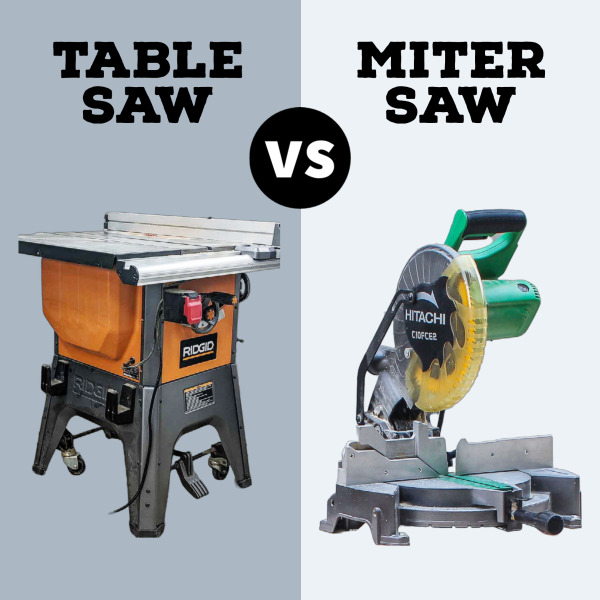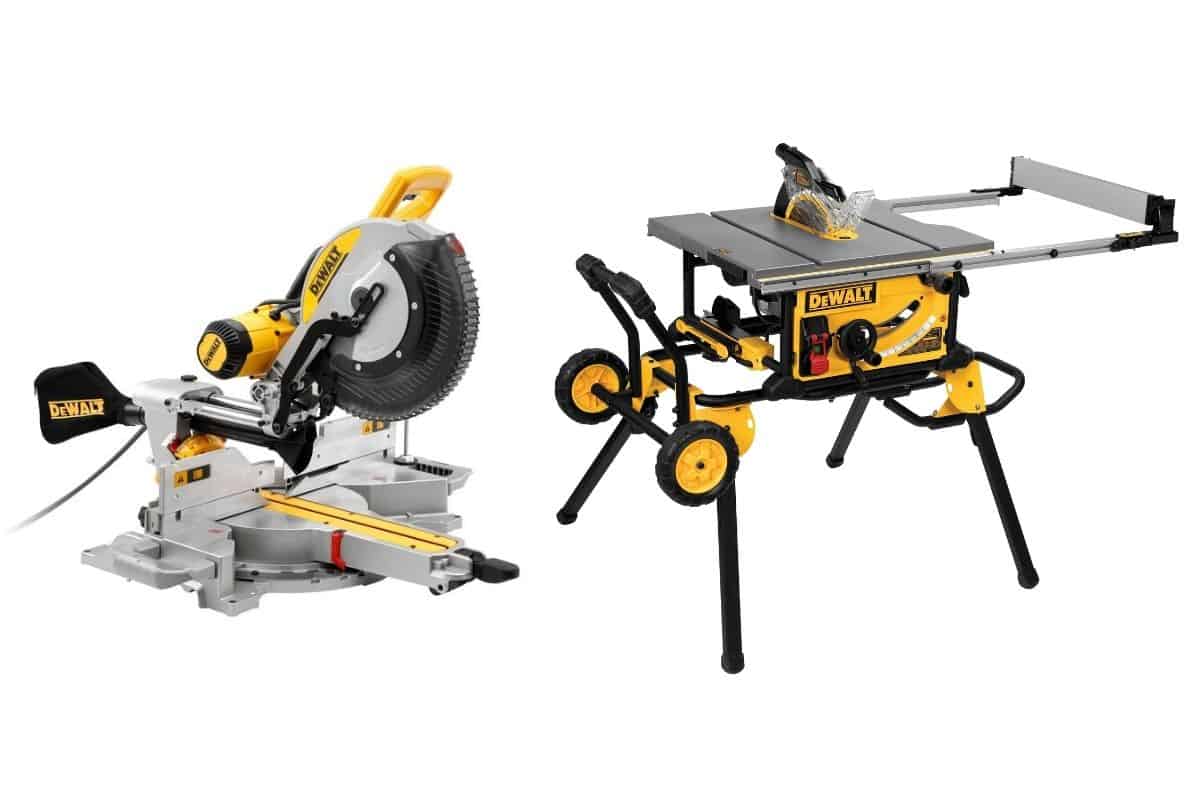Wondering if you should invest in a table saw and a miter saw? Let’s dive in!
If you’re into woodworking or DIY projects, these tools can be a game-changer.
But do you really need both? We’ll explore the pros and cons to help you decide. Let’s get started!
Looking to take your woodworking skills to the next level? While both a table saw and a miter saw have their own advantages, having both can greatly enhance your capabilities. A table saw allows for precise and straight cuts, while a miter saw is perfect for making angled cuts. With these two tools, you’ll have the versatility to tackle a wide range of projects and achieve professional-level results.

**
Do I Need a Table Saw and a Miter Saw?: A Guide to Choosing the Right Tools for Your Needs
**
**Introduction:**
When it comes to woodworking and DIY projects, having the right tools is essential. Two of the most commonly debated tools are the table saw and the miter saw. Both have their unique features and applications, but do you really need both in your workshop? In this article, we will dive into the benefits, differences, and practical considerations to help you determine if you should invest in a table saw, a miter saw, or both.
**
Benefits of a Table Saw
**
A table saw is a versatile tool that provides exceptional accuracy and efficiency in making straight cuts. It consists of a circular saw blade mounted on an arbor, rotating in an upward direction through a slot in the table. Here are some key benefits that a table saw offers:
**Versatility**: Whether you’re cutting large sheets of plywood or making precise rip cuts, a table saw can handle a wide range of tasks. Its adjustable fence allows for accurate cuts at various angles and dimensions.
**Straight Cuts**: The sturdy table and rip fence of a table saw provide excellent support for cutting long, straight lines. This tool excels in ripping boards or cutting wide panels accurately.
**Safety Features**: Modern table saws include advanced safety features like blade guards, riving knives, and anti-kickback pawls. These mechanisms help prevent accidents and make woodworking safer for beginners and professionals.
**
Benefits of a Miter Saw
**
A miter saw, also known as a chop saw, is designed to make precise angled cuts. It consists of a circular saw blade mounted on a pivoting arm, allowing you to rotate the blade to various angles. Here are the key benefits of a miter saw:
**Angled Cuts**: If your projects involve cutting angles other than 90 degrees, a miter saw is the perfect tool. It allows you to make accurate bevel cuts, miter cuts, compound miter cuts, and even crosscuts.
**Speed and Efficiency**: A miter saw is known for its quick setup and efficient cutting. You can make repetitive cuts with precision, making it ideal for jobs like installing moldings, cutting trim work, or creating picture frames.
**Portability**: Compared to a table saw, a miter saw is generally lighter and more portable. Some models even come with foldable stands or handles, allowing you to easily transport and use it on job sites.
**
Should You Choose a Table Saw or a Miter Saw?
**
**Project Requirements**: Before deciding whether you need a table saw or a miter saw, consider the type of projects you undertake most frequently. If you primarily work with large sheets of material or require precise straight cuts, a table saw is a must-have. On the other hand, if your projects involve a lot of angled cuts and moldings, a miter saw may better suit your needs.
**Budget Considerations**: The cost of these tools can vary significantly. A high-quality table saw tends to be more expensive than a miter saw. If you’re just starting or have a limited budget, it may be more practical to invest in a miter saw initially, as it can still handle various cutting tasks. You can always add a table saw to your workshop as your skills and projects progress.
**The Best of Both Worlds**: If budget and space allow, owning both a table saw and a miter saw can provide the ultimate versatility in your woodworking projects. By combining the straight-cutting capabilities of a table saw with the precision angled cuts of a miter saw, you can tackle a wide range of tasks with ease.
**Tip:** Consider purchasing a versatile combination machine that combines the functions of both a table saw and a miter saw. These hybrid machines offer the advantage of space-saving while still delivering the necessary features for most woodworking projects.
**
Table Saw vs. Miter Saw: Which is Ideal for Your Needs?
**
**Cutting Capacity**: A table saw shines when cutting long and wide materials. It excels at ripping boards, making crosscuts, and bevel cuts. A miter saw, however, is the go-to tool for accurately cutting angles, whether it’s creating miter joints or making compound cuts.
**Precision**: If precise and repeatable cuts are a priority, a miter saw is the winner. Its miter and bevel scales allow for precise adjustments and measurements. A table saw, while accurate, may require additional accessories like a miter gauge to achieve the same level of precision.
**Safety**: Both tools have safety features, but a table saw comes out on top in terms of overall safety. The blade guard, riving knife, and anti-kickback features provide added protection during operation. However, always follow proper safety practices and wear personal protective equipment when using any power tools.
**Versatility**: For general woodworking needs, a table saw is more versatile due to its ability to handle both straight and angled cuts. A miter saw, while excellent at angled cuts, may be limited when it comes to ripping or cutting wide panels.
**Summary:**
In conclusion, whether you need a table saw, a miter saw, or both ultimately depends on the type of projects you undertake and your budget. A table saw offers versatility and straight-cutting capabilities, while a miter saw excels in angled cuts and trim work. Assess your specific needs and consider the benefits each tool provides to make an informed decision. Remember, as your skills and projects evolve, adding the missing tool to your workshop can enhance your woodworking capabilities. Happy crafting!
Key Takeaways: Do I Need a Table Saw and a Miter Saw?
- Having a table saw and a miter saw can be beneficial for different woodworking tasks.
- A table saw is perfect for ripping boards and cutting large pieces of wood.
- A miter saw is excellent for making angled cuts and precise crosscuts.
- Both tools have their specific uses and can complement each other in various woodworking projects.
- Ultimately, the need for a table saw and a miter saw depends on the type of woodworking tasks you plan to undertake.
Frequently Asked Questions
Are you wondering if you need a table saw and a miter saw? Check out these commonly asked questions to help you decide!
1. What is the difference between a table saw and a miter saw?
A table saw is a versatile tool used for cutting large sheets of wood or making straight cuts on boards. It has a flat table surface and a circular blade that cuts vertically. On the other hand, a miter saw is designed for making precise crosscuts and angled cuts. It has a pivoting arm and a circular blade that cuts horizontally or diagonally.
While both saws can make various types of cuts, the main difference lies in their purpose and function. A table saw excels at ripping large pieces of wood, while a miter saw is perfect for making precise cuts at different angles.
2. Do I need both a table saw and a miter saw for woodworking?
It depends on the type of woodworking projects you plan to undertake. If you primarily work with long and wide boards, a table saw is a valuable tool for ripping and crosscutting. It offers better stability and allows you to make precise straight cuts. However, if your projects involve more detailed work, like trim or molding, a miter saw is essential. It provides accurate crosscuts at different angles quickly and efficiently.
In summary, having both a table saw and a miter saw is ideal for a well-rounded woodworking workshop. However, if you have limited space or budget, you can prioritize based on the types of projects you frequently work on.
3. Can a miter saw perform the same tasks as a table saw?
No, a miter saw cannot fully replace a table saw. While a miter saw is excellent for making angle cuts and crosscuts, it lacks the ability to rip long boards or handle wide pieces of wood. The wide table and the precise fence system of a table saw provide stability and accuracy when ripping stock.
However, if you’re working on small projects or making precise cuts at different angles, a miter saw can handle those tasks efficiently. It’s always best to have both tools to cover a wider range of woodworking needs.
4. Which saw should I invest in first if I’m just starting out?
If you’re just starting out with woodworking, it’s recommended to invest in a table saw first. A table saw offers more versatility and can handle a wide range of woodworking tasks. It’s a great foundational tool that allows you to make straight cuts, rip boards, and create various joints. It’s also safer and easier to control when cutting larger pieces of wood.
Once you have a table saw, you can gradually add a miter saw to your collection, especially if you find yourself working on projects that require precise angle cuts or detailed crosscuts.
5. Can I use alternative tools instead of a table saw and a miter saw?
While alternative tools like circular saws, jigsaws, or hand saws can perform some similar tasks, they may not offer the same level of precision and efficiency as a table saw and a miter saw. These alternative tools may be suitable for occasional use or small projects, but if you’re serious about woodworking, investing in dedicated tools like a table saw and a miter saw will greatly enhance your capabilities and productivity.
Having the right tools for the job ensures better accuracy, safety, and efficiency, allowing you to tackle a wider range of woodworking projects with confidence.

Should You Buy A Miter Saw? – Beginner Woodworker’s guide
Summary
Having both a table saw and a miter saw can be helpful for different types of woodworking projects.
A table saw is great for making straight cuts and working with larger pieces of wood. It’s like a big, powerful saw that stays still while you move the wood through it.
On the other hand, a miter saw is perfect for making angled cuts and working with smaller pieces of wood. It’s like a chop saw that you can spin around to cut at different angles.
So, if you’re serious about woodworking, having both tools will give you more versatility and make your projects easier to complete. But if you’re just starting out or on a tight budget, you can still do a lot with just one of these saws.
Remember, it’s important to always prioritize safety and use the right tool for the job. Happy woodworking!
